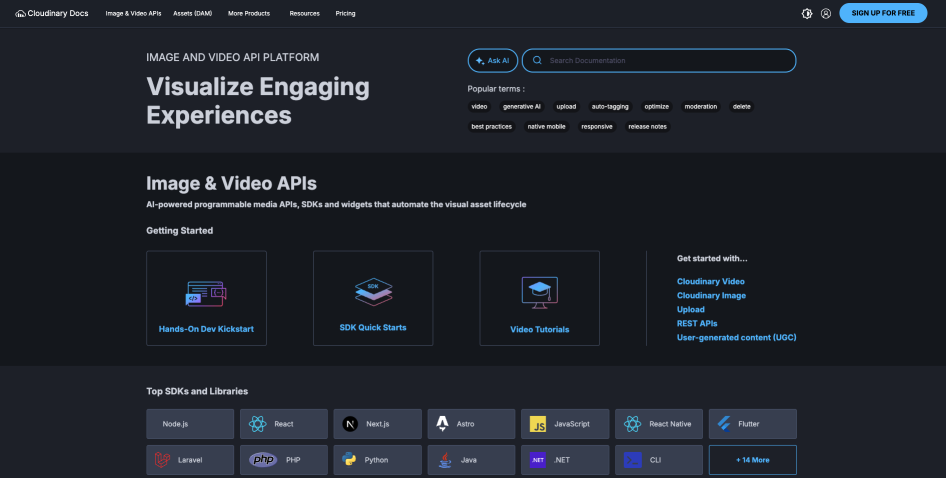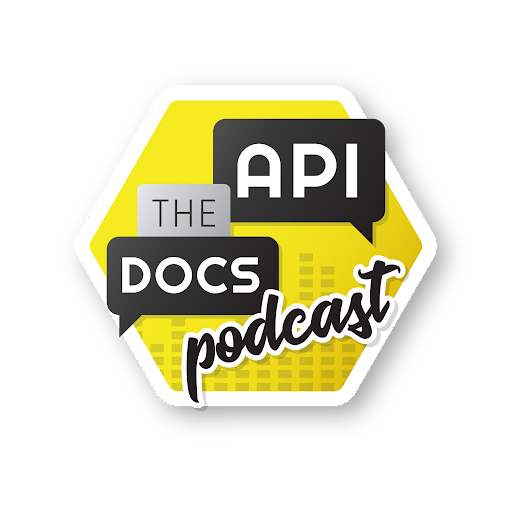
Cloudinary
NOMINEE OVERVIEW
Cloudinary’s Developer Portal is the gateway to everything developers need to build with Cloudinary’s image and video APIs. From onboarding tutorials to use-case guides, SDK quick starts, and API references, it supports a diverse, global developer audience, especially in industries like e-commerce, travel, and hospitality where fast, high-quality visual experiences are critical.
We’re evolving alongside developers’ workflows, combining intuitive UX with AI-powered tools built for modern coding experiences. Whether exploring our documentation in a browser, asking our embedded multilingual “Ask Cloudinary AI” bot a question, or prompting an LLM-integrated IDE using Cloudinary’s MCP servers and structured markdown doc context, developers get fast, reliable answers with minimal context-switching.
Our developer experience is both comprehensive and intentional. We offer content tailored to different learning styles, from interactive code explorers to Postman collections and demo apps to video tutorials. We design for discoverability and accessibility across formats, devices, and languages. Behind the scenes, we track engagement across the portal and run continuous A/B testing on key flows, allowing us to double down on what works and move quickly on what doesn't.
As developer needs evolve, so does our commitment to building LLM-ready, context-rich tools that meet them wherever they are.
NOMINATION RATIONALE
1) BEST AI-ENABLED DEVELOPER PORTAL
Cloudinary’s developer portal is designed for how today's developers like to work: using natural language, taking advantage of LLMs, and with minimal context switching. That’s why we’ve prioritized intelligent, in-portal natural language assistance, first-class support for external LLM clients, and internal use of AI to improve both productivity and quality.
Our multilingual “Ask Cloudinary AI” bot is trained on our docs, and enhanced with guidance on when and how to prompt users for additional information before answering. It gives fast, accurate answers, and has been used by several thousand visitors in over 30 different languages. From our data, those who use it are more likely to activate within their first week and to submit fewer support requests.
For LLM-integrated workflows, we’ve built a full ecosystem of Cloudinary-trained resources designed to work inside tools like Cursor, Claude, WindSurf, and VSCode. These include multiple MCP servers, LLMS.txt, IDE rules files, and auto-generated markdown versions of every doc page that include metadata to further improve LLM interpretation. Developers can copy the link or download our markdown versions right from our portal pages so their LLM-powered IDEs can give them more accurate, Cloudinary-specific responses, and generate reliable API and SDK code for them.
This dual commitment to interactive UX and robust LLM support means developers can build faster, with less friction. We’ve internally validated these tools by building our own production-ready Cloudinary implementations using only natural language prompts.
Soon, we’ll launch a new “LLM Powerstart” onboarding journey to help developers integrate Cloudinary via their LLM-powered IDE from day one.
Our focus on AI isn't limited to external offerings. As a team, we use AI-based tools on a daily basis for automating repetitive tasks, reviewing our content and code for quality, consistency, and experience, and for creating agentic tools that integrate into and simplify our every day processes.
Our AI-first approach isn’t just about functionality; it’s about removing barriers for both our team and our end users so everyone can focus on building.
2) BEST ONBOARDING EXPERIENCE IN A DEVELOPER PORTAL
Great onboarding doesn’t just help developers implement a library. It helps them immediately see the value of what they’re building. Cloudinary’s doc portal journey guides developers from zero to “aha” using tailored paths that match their learning style, time constraints, and use case.
Our portal home page surfaces a streamlined "Get Started" section, along with top SDKs and popular search terms to help developers quickly discover what's available and let them choose the best way for them to start. A free registration button is available from every page, removing friction so developers can dive in to try things on their own accounts.
We support a range of onboarding journeys. Our flagship Kickstart tutorial combines walk-through implementation with business-value discovery, while the SDK Quickstarts offer a 5-minute, step-by-step copy-paste-and-go methodology for runnable projects that show instant results.
Developers can also explore our Video Tutorial Library, Try it - Code Explorers page offering editable code sandboxes and links to corresponding GitHub repos, Postman collections, or more in-depth use-case guides. Every piece is designed to make complex concepts feel accessible.
We constantly iterate on our onboarding resources based on real usage and feedback. We track engagement, from homepage clicks to Kickstart completion rates and page satisfaction scores. A unique CDN-based A/B testing system helps us validate hypotheses about what activates and converts users.




